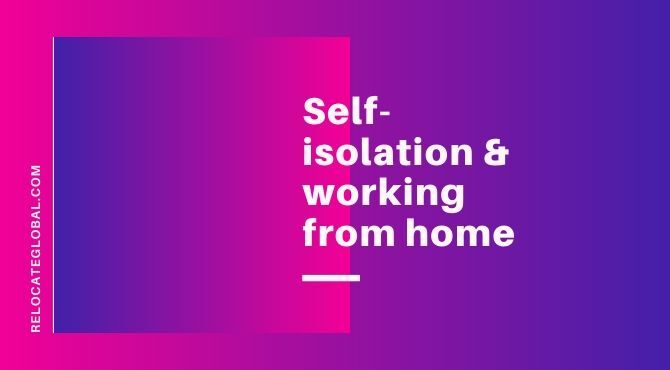Self-isolation and Coronavirus: How to manage a remote workforce
Governments around the world are recommending or mandating home working to minimise the spread of the coronavirus, and to protect the most vulnerable in societies. How can organisations best make home working "work" during a time of self-isolation?

Know your team
You might assume that introverted people, who are more comfortable spending time alone and working under their own steam, are more accustomed to working flexibly than extroverts, who feel a much greater need for social interaction. The reality, however, is that extroverted people are much more likely to adapt well to agile working.It’s vital that remote workers remain in touch with their wider team, and this is something at which extroverts excel. They are much more likely to proactively make contact, while introverts find it harder to initiate conversation and risk becoming even more detached.
Managers should be encouraged to get to know their remote workers as well as possible. If you know that you have an introverted person on your team, it’s likely that you will need to provide that extra bit of encouragement for them to communicate.
Don’t rely on email
The vast majority of managers over-rely on email. It’s a great tool for communicating facts and figures but hearing someone say something is very different from reading it, and this has the potential to create all sorts of underlying tensions and confusion. Pearn Kandola's research has found it to be the biggest source of workplace conflict.Consider the following scenario. Your manager has asked you to carry out a task, but in a way which you know is not the most efficient. You send an email, explaining that you are happy to carry out this task, but that you would suggest doing so in a slightly different way. Your manager replies with an email that simply reads, “OK. Fine.”
If this conversation was in person, or even over the phone, you might know from the tone of your manager’s voice if they are happy with your suggestion or frustrated that you have questioned their instructions. It’s much more difficult to interpret how they might feel when you’re reading their reply in an email - managers of remote teams should pick up the phone as much as possible.
Related article:
Coronavirus – what steps should employers and staff take now?
Find time to socialise
It might not always feel so, but the workplace is an incredibly social environment. Whether it be the comradery that comes with sharing a joke or simply taking turns to make a round of tea or coffee, when you’re working remotely, you miss out on these interactions. This might not appear to have a huge impact on job performance, but it does affect inter-team relationships.One way that leaders can encourage more interaction within their teams is by factoring social time into teleconference calls. Try to set aside a few minutes at the beginning of the call for social exchanges, or if there is time, even invite colleagues to dial into the call early for a quick catch-up.
Where possible, it’s even more beneficial to communicate with video-conferencing facilities such as Skype and Facetime. The ability to make eye contact, and to read facial cues and body language, adds an additional layer of connection which can’t be achieved over the phone.
If you are interested in talent management and creating the best environment for your team, you might be interested in these related articles:
- What has happened to trust and how can we regain it?
- Creating a high-performance, humane workforce for the future
- How to outsmart your own bias for a better working environments
Establish trust
One of the key challenges when it comes to managing a remote workforce is that of establishing trust. This hinges, in part, on understanding that there are two types of trust. The first is cognitive trust, which is trust in someone’s experience, knowledge and ability. This can be developed remotely, through means such as conference calls and emails. The second type is emotional trust, which determines how much one person likes and believes in another. Emotional trust can only be grown through face-to-face interaction and is therefore much more difficult to establish in a remote workforce.Leading a team of people who you can’t physically see working requires a great deal of trust. Leaders must, therefore, build an atmosphere of psychological safety, in which their team can work without fear that their managers don’t trust them. It’s vital that leaders understand the mechanics of trust, in order to identify where it might be missing from their team.
We are closely following the impact of the Coronavirus on education, global moves, and the global economy. If you or your child's education has been impacted by COVID-19, let us know by emailing: editorial@relocatemagazine.com
Visit the Relocate Global Coronavirus Resource Centre for more information on how to manage risk and best protect yourself and your employees.
Subscribe to Relocate Extra, our monthly newsletter, to get all the latest international assignments and global mobility news.
Relocate’s new Global Mobility Toolkit provides free information, practical advice and support for HR, global mobility managers and global teams operating overseas. Access hundreds of global services and suppliers in our Online Directory
Access hundreds of global services and suppliers in our Online Directory
©2025 Re:locate magazine, published by Profile Locations, Spray Hill, Hastings Road, Lamberhurst, Kent TN3 8JB. All rights reserved. This publication (or any part thereof) may not be reproduced in any form without the prior written permission of Profile Locations. Profile Locations accepts no liability for the accuracy of the contents or any opinions expressed herein.






































